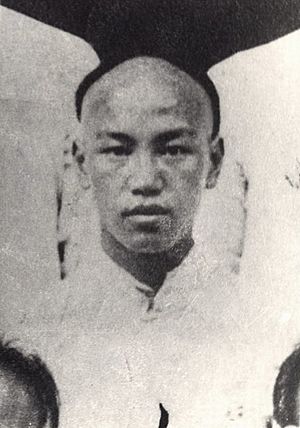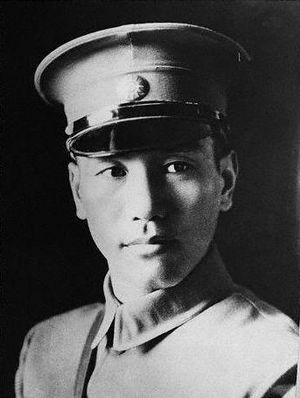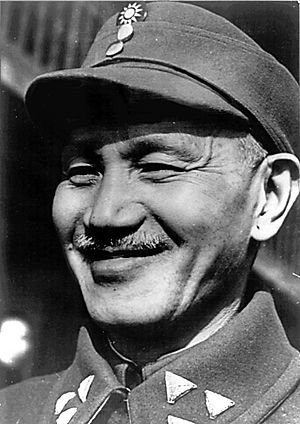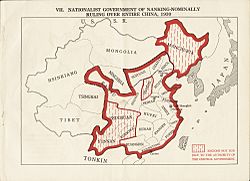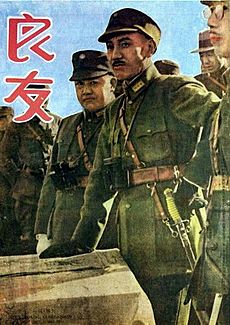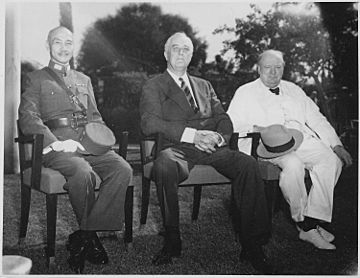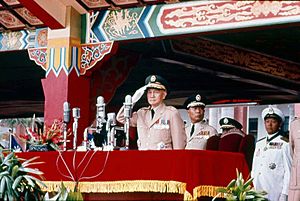Chiang Kai-shek facts for kids
Quick facts for kids
Generalissimo
Chiang Kai-shek
|
|||||||||||||||||||||||||||||||||
|---|---|---|---|---|---|---|---|---|---|---|---|---|---|---|---|---|---|---|---|---|---|---|---|---|---|---|---|---|---|---|---|---|---|
|
蔣中正
蔣介石 |
|||||||||||||||||||||||||||||||||

Official portrait, 1943
|
|||||||||||||||||||||||||||||||||
| Chairman of the National Government of China | |||||||||||||||||||||||||||||||||
| In office 10 October 1943 – 20 May 1948 Acting: 1 August 1943 – 10 October 1943 |
|||||||||||||||||||||||||||||||||
| Premier | T. V. Soong | ||||||||||||||||||||||||||||||||
| Vice Chairman | Sun Fo | ||||||||||||||||||||||||||||||||
| Preceded by | Lin Sen | ||||||||||||||||||||||||||||||||
| Succeeded by | Position abolished (himself as President of the Republic of China) | ||||||||||||||||||||||||||||||||
| In office 10 October 1928 – 15 December 1931 |
|||||||||||||||||||||||||||||||||
| Premier | Tan Yankai T. V. Soong |
||||||||||||||||||||||||||||||||
| Preceded by | Tan Yankai | ||||||||||||||||||||||||||||||||
| Succeeded by | Lin Sen | ||||||||||||||||||||||||||||||||
| President of the Republic of China | |||||||||||||||||||||||||||||||||
| In office 1 March 1950 – 5 April 1975 |
|||||||||||||||||||||||||||||||||
| Premier | Yan Xishan Chen Cheng Yu Hung-Chun Yen Chia-kan Chiang Ching-kuo |
||||||||||||||||||||||||||||||||
| Vice President | Li Zongren Chen Cheng Yen Chia-kan |
||||||||||||||||||||||||||||||||
| Preceded by | Li Zongren (acting) | ||||||||||||||||||||||||||||||||
| Succeeded by | Yen Chia-kan | ||||||||||||||||||||||||||||||||
| In office 20 May 1948 – 21 January 1949 |
|||||||||||||||||||||||||||||||||
| Premier | Chang Chun Wong Wen-hao Sun Fo |
||||||||||||||||||||||||||||||||
| Vice President | Li Zongren | ||||||||||||||||||||||||||||||||
| Preceded by | Position established (himself as Chairman of the Nationalist government) | ||||||||||||||||||||||||||||||||
| Succeeded by | Li Zongren (acting) | ||||||||||||||||||||||||||||||||
| Premier of the Republic of China | |||||||||||||||||||||||||||||||||
| In office 20 November 1939 – 31 May 1945 |
|||||||||||||||||||||||||||||||||
| President | Lin Sen | ||||||||||||||||||||||||||||||||
| Vice Premier | H. H. Kung | ||||||||||||||||||||||||||||||||
| Preceded by | H. H. Kung | ||||||||||||||||||||||||||||||||
| Succeeded by | T. V. Soong | ||||||||||||||||||||||||||||||||
| In office 9 December 1935 – 1 January 1938 |
|||||||||||||||||||||||||||||||||
| President | Lin Sen | ||||||||||||||||||||||||||||||||
| Vice Premier | H. H. Kung | ||||||||||||||||||||||||||||||||
| Preceded by | Wang Jingwei | ||||||||||||||||||||||||||||||||
| Succeeded by | H. H. Kung | ||||||||||||||||||||||||||||||||
| In office 4 December 1930 – 15 December 1931 |
|||||||||||||||||||||||||||||||||
| President | Himself | ||||||||||||||||||||||||||||||||
| Vice Premier | T. V. Soong | ||||||||||||||||||||||||||||||||
| Preceded by | T. V. Soong | ||||||||||||||||||||||||||||||||
| Succeeded by | Chen Mingshu (acting) | ||||||||||||||||||||||||||||||||
| Acting Premier of the Republic of China | |||||||||||||||||||||||||||||||||
| In office 1 March 1947 – 18 April 1947 |
|||||||||||||||||||||||||||||||||
| President | Himself | ||||||||||||||||||||||||||||||||
| Vice Premier | Weng Wenhao | ||||||||||||||||||||||||||||||||
| Preceded by | T. V. Soong | ||||||||||||||||||||||||||||||||
| Succeeded by | Chang Chun | ||||||||||||||||||||||||||||||||
| Chairman of the Kuomintang | |||||||||||||||||||||||||||||||||
| In office 12 May 1936 – 1 April 1938 |
|||||||||||||||||||||||||||||||||
| Preceded by | Hu Hanmin | ||||||||||||||||||||||||||||||||
| Succeeded by | Himself as Director-General of the Kuomintang | ||||||||||||||||||||||||||||||||
| In office 6 July 1926 – 11 March 1927 |
|||||||||||||||||||||||||||||||||
| Preceded by | Zhang Renjie | ||||||||||||||||||||||||||||||||
| Succeeded by | Woo Tsin-hang and Li Yuying | ||||||||||||||||||||||||||||||||
| Director-General of the Kuomintang | |||||||||||||||||||||||||||||||||
| In office 1 April 1938 – 5 April 1975 |
|||||||||||||||||||||||||||||||||
| Deputy | Wang Jingwei Chen Cheng |
||||||||||||||||||||||||||||||||
| Preceded by | Position established | ||||||||||||||||||||||||||||||||
| Succeeded by | Chiang Ching-kuo (as Chairman of the Kuomintang) | ||||||||||||||||||||||||||||||||
| Chairman of the Military Affairs Commission | |||||||||||||||||||||||||||||||||
| In office 15 December 1931 – 31 May 1946 |
|||||||||||||||||||||||||||||||||
| Preceded by | Position established | ||||||||||||||||||||||||||||||||
| Succeeded by | Position abolished | ||||||||||||||||||||||||||||||||
| Personal details | |||||||||||||||||||||||||||||||||
| Born |
Chiang Jui-yüan (蔣瑞元)
31 October 1887 Xikou, Zhejiang, Qing Dynasty |
||||||||||||||||||||||||||||||||
| Died | 5 April 1975 (aged 87) Taipei, Republic of China |
||||||||||||||||||||||||||||||||
| Resting place | Cihu Mausoleum, Taoyuan, Taiwan | ||||||||||||||||||||||||||||||||
| Political party | Kuomintang | ||||||||||||||||||||||||||||||||
| Spouses |
Mao Fumei
(m. 1901; div. 1921)Yao Yecheng
(m. 1913–1927)Chen Jieru
(m. 1921–1927)Soong Mei-ling
(m. 1927) |
||||||||||||||||||||||||||||||||
| Children |
|
||||||||||||||||||||||||||||||||
| Alma mater | Baoding Military Academy, Tokyo Shinbu Gakko | ||||||||||||||||||||||||||||||||
| Signature | |||||||||||||||||||||||||||||||||
| Nicknames |
|
||||||||||||||||||||||||||||||||
| Military service | |||||||||||||||||||||||||||||||||
| Allegiance | |||||||||||||||||||||||||||||||||
| Branch/service |
|
||||||||||||||||||||||||||||||||
| Years of service | 1909–1975 | ||||||||||||||||||||||||||||||||
| Rank | Generalissimo (特級上將) | ||||||||||||||||||||||||||||||||
| Battles/wars |
|
||||||||||||||||||||||||||||||||
| Chinese name | |||||||||||||||||||||||||||||||||
| Traditional Chinese | 蔣介石 | ||||||||||||||||||||||||||||||||
| Simplified Chinese | 蒋介石 | ||||||||||||||||||||||||||||||||
|
|||||||||||||||||||||||||||||||||
| Register name | |||||||||||||||||||||||||||||||||
| Traditional Chinese | 蔣周泰 | ||||||||||||||||||||||||||||||||
| Simplified Chinese | 蒋周泰 | ||||||||||||||||||||||||||||||||
|
|||||||||||||||||||||||||||||||||
| Milk name | |||||||||||||||||||||||||||||||||
| Traditional Chinese | 蔣瑞元 | ||||||||||||||||||||||||||||||||
| Simplified Chinese | 蒋瑞元 | ||||||||||||||||||||||||||||||||
|
|||||||||||||||||||||||||||||||||
| School name | |||||||||||||||||||||||||||||||||
| Traditional Chinese | 蔣志清 | ||||||||||||||||||||||||||||||||
| Simplified Chinese | 蒋志清 | ||||||||||||||||||||||||||||||||
|
|||||||||||||||||||||||||||||||||
| Adopted name | |||||||||||||||||||||||||||||||||
| Traditional Chinese | 蔣中正 | ||||||||||||||||||||||||||||||||
| Simplified Chinese | 蒋中正 | ||||||||||||||||||||||||||||||||
|
|||||||||||||||||||||||||||||||||
Chiang Kai-shek (born October 31, 1887 – died April 5, 1975) was a very important Chinese leader. He was a Nationalist politician and military general. He led the Republic of China (ROC) from 1928 until his death in 1975. At first, he led all of Mainland China. After 1949, he led the government only in Taiwan.
Chiang was a member of the Kuomintang (KMT) political party. He worked with Sun Yat-sen to overthrow the old government and unite China. With help from the Soviet Union and the Communist Party of China (CCP), Chiang built up the military. He also led the Whampoa Military Academy. As the main commander of the National Revolutionary Army, he was known as a Generalissimo.
From 1926 to 1928, he led the Northern Expedition. This campaign helped unite China under the Nationalist government. However, during this time, the alliance between the KMT and the Communists broke down. Chiang ordered actions against Communists within his party. This started a civil war with the CCP. He eventually lost this war in 1949.
As leader of the Republic of China, Chiang tried to make China modern. He also had to defend the nation from the Communists, local warlords, and the growing threat from Japan. He tried to avoid war with Japan while fighting the Communists. But in 1936, he was kidnapped in the Xi'an Incident. This forced him to form an alliance with the Communists to fight Japan.
In 1937, the Second Sino-Japanese War began. Chiang led China's fight against Japan for eight years. He worked with Allied powers like the US and Britain. After World War II ended, the civil war with the Communists, led by Mao Zedong, started again. Chiang's forces were defeated. In 1949, Chiang's government and army moved to the island of Taiwan. There, he declared martial law. This led to a period called the White Terror, where people who spoke out against the government faced harsh treatment.
Despite this, Taiwan saw many social reforms and economic growth under his leadership. Chiang was elected president five times. He died in 1975, still leading the Republic of China in Taiwan.
Chiang Kai-shek was one of the longest-serving leaders in the 20th century. He is a controversial figure. Supporters say he helped unite China and led the fight against Japan. They also credit him with stopping Communist influence and helping Taiwan's economy grow. Critics say he was a harsh leader. They accuse his government of being corrupt and suppressing people. Some historians say his ideas were different from other dictators. They note his efforts to improve life in China and Taiwan. He also helped China become more independent from foreign powers. He moved many Chinese treasures to Taiwan, saving them from possible destruction.
Contents
- What Was Chiang Kai-shek Called?
- Early Life and Education
- Returning to China and Joining the Revolution
- Building the Kuomintang's Power
- Rise to Power
- Leading China
- Second Sino-Japanese War
- Second Phase of the Chinese Civil War
- On Taiwan
- Death
- How Was Chiang Seen?
- Family Life
- Beliefs and Relationships
- Awards and Honors
- Images for kids
- See also
What Was Chiang Kai-shek Called?
Chiang Kai-shek used several names during his life. His family knew him as Chiang Chou-t‘ai. When he was born, his "milk name" was Chiang Jui-yüan.
In 1903, at age 16, he chose a "school name," Zhiqing. This means "purity of aspirations." For about 15 years, he was known as Jiang Zhiqing.
Around 1912, he started using the name Chiang Kai-shek. He used it as a pen name for articles he wrote. "Kai-shek" is how his name sounds in Cantonese, a Chinese dialect. This name became his courtesy name. It means "firm as a rock."
Later, around 1917 or 1918, he changed his name to Jiang Zhongzheng. This name means "central uprightness." It was similar to Sun Yat-sen's name, Zhongshan, meaning "central mountain." This showed he was a true follower of Sun Yat-sen. This name is still common in Taiwan. Many places in Taiwan are named "Chung-cheng" after him.
Early Life and Education
Chiang was born on October 31, 1887, in Xikou, Zhejiang province, China. His family were successful salt merchants. His father died when Chiang was eight. He looked up to his mother, who taught him about Confucian virtues. He was a spirited child who was interested in war from a young age.
In 1906, Chiang cut off his queue, a hairstyle required by the old Qing dynasty. This shocked people in his hometown.
Studying in Japan
Chiang grew up when China was facing many problems. The country was weak from military defeats, disasters, and foreign demands. He visited Japan in 1906 to study military skills. He felt strong nationalist feelings and wanted to make China strong again.
He started military training at the Baoding Military Academy in 1906. Then, in 1907, he went to Tokyo Shinbu Gakko in Japan. This was a school for Chinese students hoping to join the Imperial Japanese Army Academy. There, he met other Chinese students who wanted to overthrow the Qing dynasty. He joined the Tongmenghui, a revolutionary group. From 1909 to 1911, Chiang served in the Imperial Japanese Army.
Returning to China and Joining the Revolution
In 1911, Chiang returned to China when the Wuchang uprising began. He joined the revolutionary forces in Shanghai. He worked under his friend Chen Qimei. Chiang became a founding member of the Nationalist Party.
After the old government was replaced, a new leader, Yuan Shikai, took over. When a second revolution failed in 1913, Chiang went into exile in Japan. He also spent time in Shanghai. In Shanghai, he connected with local gangs, like the Green Gang. In 1916, Chen Qimei was killed. Chiang then became the leader of the Chinese Revolutionary Party in Shanghai.
Building the Kuomintang's Power
In 1917, Sun Yat-sen moved his base to Guangzhou. Chiang joined him in 1918. Sun faced challenges, but in 1920, he regained control of Guangdong province. A disagreement arose between Sun and the local governor, Chen Jiongming. In 1922, Chen's general attacked Sun's palace. Sun escaped, and Chiang quickly joined him. Chiang stayed with Sun for about 50 days, protecting him. This earned Chiang Sun's lasting trust.
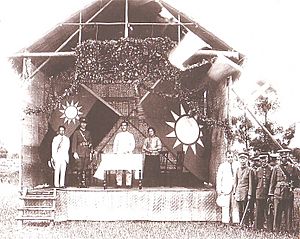
In 1923, Sun regained control of Guangdong again. He reformed the KMT to unite China. Sun sent Chiang to Moscow for three months to study the Soviet system. Chiang met Soviet leaders but decided their government model was not right for China.
In 1924, Sun made Chiang the leader of the Whampoa Military Academy. This school helped Chiang train young officers who were loyal to the KMT and to him.
Rise to Power
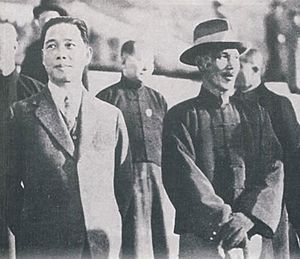
Sun Yat-sen died in 1925, creating a power struggle in the KMT. Chiang gained more influence. In March 1926, he declared martial law and reduced Communist and Soviet influence in the army and party. The right wing of the KMT supported him.
On June 5, 1926, Chiang became the commander-in-chief of the National Revolutionary Army. On July 27, he launched the Northern Expedition. This campaign aimed to defeat local warlords and unite China under the KMT.
In January 1927, some KMT members, led by Wang Jingwei, moved the government to Wuhan. Chiang took Nanjing in March. He then decided to break away from Wang's group, which he felt threatened his control.
On April 12, 1927, Chiang ordered a crackdown on suspected Communists in Shanghai. This led to many deaths and is known as the "White Terror" in mainland China. Many Communists left the cities and went to the countryside. Chiang's actions started the Chinese Civil War.
The Nationalist army continued to advance. In June 1928, they captured Beijing. This completed Chiang's goal of uniting China and ended the Warlord Era.
After the Northern Expedition, some warlords tried to challenge Chiang's government. But Chiang defeated them in the Central Plains War.
Chiang worked hard to be seen as Sun Yat-sen's true successor. He married Soong Mei-ling, Sun's wife's younger sister, in December 1927. He divorced his previous wives and promised to study Christianity. He became a Christian three years after his marriage. Some thought this was for political reasons, but his diaries show his faith was strong.
When he reached Beijing, Chiang honored Sun Yat-sen. He had Sun's body moved to a special mausoleum in Nanjing.
In the West and the Soviet Union, Chiang Kai-shek was sometimes called the "Red General." His portrait was even displayed in Moscow.
Leading China
After uniting China, Chiang became the director of the State Council in October 1928, like a president. He was called "Generalissimo" by the Western media.
Sun Yat-sen had planned for China to develop in three steps: military rule, political guidance, and then constitutional rule. Chiang's leadership began the "political guidance" period. During this time, China started to develop many modern government features.
From 1928 to 1937, known as the Nanjing decade, China improved its legal system and economy. They built railroads and highways and worked on public health. Education standards improved, and the national science academy was founded. The New Life Movement was started to promote traditional Chinese values. They also promoted Mandarin as the national language.
Chiang supported modern ideas like scientific progress, education for everyone, and women's rights. The KMT supported women's right to vote and ended polygamy and foot binding. They also set aside seats for women in parliament. Education improved literacy rates across China.
However, Chiang's rule faced many challenges. Warlords still controlled parts of the countryside. The 1930 Central Plains War was very costly. Chiang also faced criticism for his strong leadership. He even put a former supporter, Hu Hanmin, under house arrest.
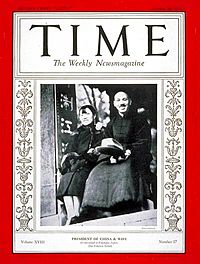
Chiang's main goal was to defeat the Communists. He led campaigns against the Chinese Soviet Republic. In 1934, his forces surrounded the Chinese Red Army. The Communists then began their famous Long March to escape. During this march, Mao Zedong became the most important leader of the Chinese Communist Party.
Chiang was a nationalist and believed in Confucianism. He thought some Western ideas were not good for China. Some people called his rule authoritarian. His government also had a group called the Blue Shirts Society, which was inspired by similar groups in Europe. They wanted to remove foreign influence and stop communism.
Chiang's government faced problems with corruption. While Chiang himself was not seen as corrupt, some people close to him were. This led to a loss of trust. The US sent aid to China, but much of it was said to disappear. Chiang tried to fight corruption with campaigns, but with mixed success.
Chiang was suspicious of foreign powers. He believed they all wanted to benefit their own countries at China's expense. He used diplomacy to try and regain Chinese territories.
First Phase of the Chinese Civil War
In 1931, after Japan invaded Manchuria, Chiang resigned as Chairman of the National Government. He returned soon after with the slogan "first internal peace, then external resistance." This meant he wanted to defeat the Communists before fighting Japan. This policy was not popular.
In December 1936, Chiang went to Xi'an to plan a major attack on the Communists. But his allied commander, Zhang Xueliang, kidnapped him. Zhang wanted Chiang to fight Japan instead of the Communists. Chiang was forced to agree to a "Second United Front" with the Communists against Japan. After this, Zhang was put under house arrest.
Second Sino-Japanese War
The Second Sino-Japanese War started in July 1937. Chiang sent his best soldiers to defend Shanghai. China suffered many casualties, but the battle showed Japan that China would keep fighting. In December, the capital city of Nanjing fell to the Japanese, leading to the Nanking massacre. Chiang moved the government inland to Chongqing.
Chiang's strategy was to draw the Japanese deeper into China. This would stretch their supply lines. He also allowed "scorched earth" tactics. For example, in 1938, the Nationalist army destroyed dams on the Yellow River to stop the Japanese. This caused a huge flood and many deaths.
In 1939, Chiang sent Muslim leaders to Middle Eastern countries to gain support for China's war against Japan.
The Japanese set up a puppet government in Nanjing, led by Wang Jingwei. Wang was a former KMT leader who turned against Chiang. He died in 1944.
After the attack on Pearl Harbor, China joined the Allied Powers. Chiang and his wife, Soong Mei-ling, gained support in the United States. Chiang was named the Supreme Commander of Allied forces in the China war zone. He met with leaders like Winston Churchill and Franklin D. Roosevelt at the Cairo Conference in 1943.
Some American military advisors criticized Chiang's government for corruption. They said money sent for building air bases was misused.
Second Phase of the Chinese Civil War
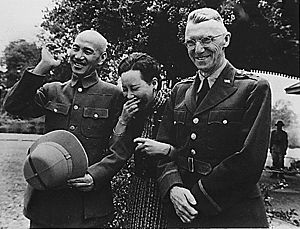
When Japan surrendered in 1945, Chiang's government was not ready to take back control of all the areas Japan had occupied. They asked the Japanese to delay their surrender until KMT forces could arrive. American troops and weapons helped the KMT reclaim cities. However, the countryside remained mostly under Communist control.
Chiang treated Japanese prisoners of war leniently. Many top Nationalist generals had trained in Japan and had good relationships with Japanese officers. Some Japanese troops even stayed in China until 1947 and joined the Nationalist army.
Civil War Conditions

Historians say the Communists won the Civil War because they made fewer mistakes. Also, Chiang's search for a strong central government upset many groups in China. His party was also weakened by the war against Japan. The Communists, on the other hand, gained support from peasants with their land reform policies.
After the war, the United States tried to encourage peace talks between Chiang and Mao Zedong. The US government limited aid to Chiang due to concerns about corruption in his government.
Chiang's government struggled with corruption and rising prices. In his diary, Chiang wrote that the KMT failed because of internal problems. The war had weakened the Nationalists. The Communists gained strength from popular support and better organization.
A new Constitution was created in 1947. Chiang was elected the first president of the Republic of China in May 1948. But the Communists did not accept this new government. Chiang resigned as president in January 1949 as KMT forces lost battles. Li Zongren, the vice-president, became acting president.
Li tried to negotiate with the Communists, but they demanded too much. Chiang also made it difficult for Li by taking government funds to Taiwan. This caused more conflict between them.
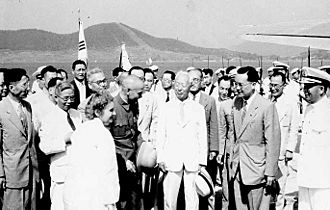
Chiang continued to give orders to the army, and many officers still followed him instead of Li. This made it hard for Li to lead. In October 1949, Communist forces captured Canton.
Retreat to Taiwan
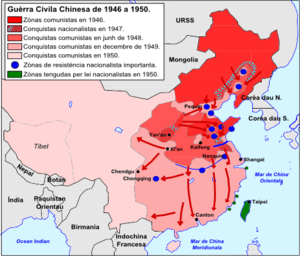
After Canton fell, Chiang moved the government to Chongqing. Li Zongren went to New York. On December 10, 1949, Communist troops surrounded Chengdu, the last KMT city on the mainland. Chiang Kai-shek and his son, Chiang Ching-kuo, flew to Taiwan. Chiang Kai-shek never returned to mainland China.
Chiang became president again on March 1, 1950. He removed Li Zongren from his vice-president position in 1954.
On Taiwan
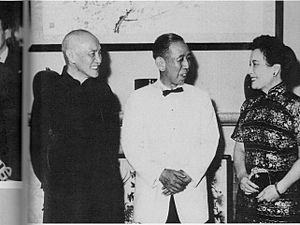
Chiang moved the government to Taipei, Taiwan. He continued to claim that his government was the rightful ruler of all of China. Most Western countries recognized his government in the United Nations until the 1970s.
During his presidency in Taiwan, Chiang still hoped to retake mainland China. He trained the army for this goal. He also supported groups fighting Communists on the mainland. He even planned an invasion in 1962.
His Rule in Taiwan
Despite having a democratic constitution, Chiang's government in Taiwan was a one-party state. The KMT, mostly made up of people from the mainland, held all the power. Laws were put in place that gave the president many powers. The goal of retaking mainland China allowed the KMT to control everything.
This period is known as the "White Terror" in Taiwan. Around 140,000 Taiwanese people were imprisoned for opposing the KMT. The government also tried to promote Chinese nationalism. They discouraged local Taiwanese culture and languages.
Under Chiang, people had some civil liberties and economic freedoms. But new elections were not held for many years. This allowed Chiang to stay president beyond the usual term limits. He was reelected four times.
Chiang believed that corruption had caused the KMT to lose mainland China. So, he tried to fight corruption in Taiwan. Some major figures from the mainland government left for the United States. Chiang's government also focused on economic development, especially in exports. A major land reform program and American aid helped Taiwan's economy grow. Taiwan became one of the "Four Asian Tigers" (fast-growing economies).
Chiang learned from his mistakes on the mainland. He promoted Sun Yat-sen's ideas of welfare and economic planning. His land reform helped many farmers own their land. He also promoted nine years of free education and the importance of science. These efforts led to strong economic growth and stable prices.
After Chiang's death, his son, Chiang Ching-kuo, became president. He and his successor, Lee Teng-hui, slowly brought more Taiwanese people into the government. They also loosened the strict controls of the early KMT rule.
Relationship with Japan and the United States
In 1971, a Japanese Prime Minister said that Japan still recognized Chiang's government because of the good relationship they had. This was because Chiang had treated Japanese prisoners of war kindly after 1945. Many Japanese leaders felt a personal debt to him.
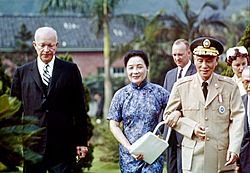
Chiang was suspicious that the United States might try to overthrow him. His son, Chiang Ching-kuo, became head of the secret police in 1950. He also reorganized the military to be more like the Soviet system. This was opposed by some generals who had trained in the US. In 1955, Chiang Ching-kuo ordered the arrest of General Sun Li-jen. Sun was accused of plotting a coup with the CIA.
Death

Chiang Kai-shek died in Taipei on April 5, 1975, at age 87. He had been ill for several months. His funeral was held on April 16. Many important people from other countries attended, including the US Vice President.
A month of mourning was declared in Taiwan. A special song was written to remember him. In mainland China, his death was reported briefly. Chiang's body was placed in a copper coffin at his favorite home in Cihu. The hope was to bury him in his birthplace on the mainland one day.
His son, Chiang Ching-kuo, became the new leader of the KMT. He later became president.
How Was Chiang Seen?
Chiang's legacy is still debated today. Some see him as a national hero. They say he united China and led the fight against Japan. He was featured on the cover of Time magazine ten times. He encouraged his people to fight until victory against Japan.
However, others blame him for not doing enough against Japan. They say he saved his armies for the fight against the Communists.
Some also see him as a strong opponent of Communism. During the Cold War, he was seen as the leader of "Free China." But critics point to his purges, authoritarian rule, and corruption in mainland China. They say his government was corrupt even before he took power. Some also say he allied with criminals.
In Taiwan, his image is often seen negatively. He is blamed for the February 28 incident in 1947. This event led to many deaths and political suppression. His memory is not often celebrated by current political parties in Taiwan.
In mainland China, his image has changed over time. For a long time, he was seen as a villain. But since the 2000s, he is sometimes shown as a Chinese nationalist. He is seen as someone who tried to unite China and fought against Japan. Movies like The Founding of a Republic (2009) and Cairo Declaration (2015) show him more sympathetically.
His ancestral home in mainland China has become a museum and tourist spot. This shows a more positive view of his role in fighting Japan.
In the United States and Europe, Chiang was often seen negatively. He was criticized for losing China to the Communists. His requests for Western money earned him the nickname "General Cash-My-Check." He was also criticized for his military decisions.
Recently, people have tried to understand Chiang better. Some historians see him as a leader overwhelmed by many challenges. He had to fight Communists, Japanese, and warlords all at once. Scholars note his efforts to build a stronger nation. Some even say that today's China is closer to Chiang's vision than to Mao Zedong's.
Family Life
Wives
-
Mao Fumei (1882–1939) was his first wife. She was the mother of his son, Chiang Ching-kuo.
In 1901, at age 14, Chiang had an arranged marriage to Mao Fumei. She was five years older and could not read. Chiang also had two concubines, Yao Yecheng and Chen Jieru. Chiang and Yao adopted a son, Chiang Wei-kuo. Chiang and Mao had a son, Chiang Ching-kuo.
Beliefs and Relationships
Chiang Kai-shek dealt with many different religions and groups during his time as leader.
Religious Views
Chiang was born a Buddhist. But he became a Methodist when he married Soong Mei-ling. His diaries show that his Christian faith was sincere.
Relationship with Muslims
Chiang had strong relationships with Muslim generals. He became a sworn brother to General Ma Fuxiang. Chiang appointed Muslim generals as governors of three provinces in northwestern China. These generals, known as the "three Mas of the Northwest," controlled armies of Muslims. Chiang asked them to fight against the Soviets, Tibetans, Communists, and Japanese. He also appointed Bai Chongxi, a Muslim general, as the Minister of National Defence.
Chiang supported Muslim General Ma Zhongying in a holy war against Soviet influence in Xinjiang. He also supported General Ma Hushan. All Muslim generals working for Chiang swore loyalty to him.
During his rule, there were some conflicts involving KMT forces and ethnic minorities. For example, in 1934, a Muslim army loyal to the KMT killed many Uyghurs in Kashgar.
Muslim leaders and publications supported Chiang's government. They used quotes from the Quran to justify his leadership and the war against Japan. Chiang sent Muslim students to study abroad and supported Muslim schools that taught loyalty to his government.
Relationship with Buddhists and Christians
Chiang had difficult relations with the Tibetans. He fought them in the Sino-Tibetan War. He also supported Muslim General Ma Bufang in his fight against Tibetan rebels. Chiang ordered Ma Bufang to prepare to invade Tibet several times to prevent Tibetan independence.
Chiang included Methodist values in his New Life Movement. He discouraged dancing and Western music. Even though he was a Methodist, he mentioned the Buddha in his diary. He also encouraged a Buddhist political party.
Awards and Honors
Chiang Kai-shek received many awards from China and other countries:
- Order of National Glory
- Order of Blue Sky and White Sun
- Order of the Sacred Tripod
- Order of Brilliant Jade
- Order of Propitious Clouds
- Order of the Cloud and Banner
- Order of Brilliant Star
- Honour Sabre of the Awakened Lion
He also received honors from countries like the Dominican Republic, Philippines, United States, South Korea, Thailand, Colombia, United Kingdom, Peru, Czechoslovakia, France, Chile, Mexico, Greece, Jordan, Brazil, Italy, Sweden, Spain, Venezuela, Vietnam, Belgium, Malawi, Bolivia, Gambia, Argentina, Guatemala, Nicaragua, and Panama.
Images for kids
-
Duke of Zhou, an ancestor of the Chiang family
See also
 In Spanish: Chiang Kai-shek para niños
In Spanish: Chiang Kai-shek para niños
- Chiangism
- Chiang Kai-shek Memorial Hall
- Chiang Kai-shek Memorial Song
- Chiang Kai-shek statues
- Chiang Kai-shek International Airport
- Cihu Mausoleum
- Free area of the Republic of China
- Guesthouses of Chiang Kai-shek
- History of the Republic of China
- History of China–United States relations to 1948
- List of kidnappings
- Politics of the Republic of China
- Republic of China (1912–1949)
- Republic of China Armed Forces
- Shilin Official Residence
- Sino-German cooperation (1926–1941)
- Timeline of Chiang Kai-shek


